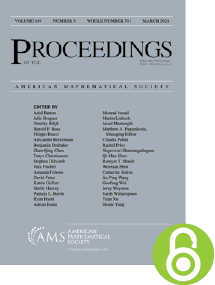Positive solutions for large random linear systems
HTML articles powered by AMS MathViewer
- by Pierre Bizeul and Jamal Najim PDF
- Proc. Amer. Math. Soc. 149 (2021), 2333-2348 Request permission
Abstract:
Consider a large linear system where $A_n$ is an $n\times n$ matrix with independent real standard Gaussian entries, ${\boldsymbol {1}}_n$ is an $n\times 1$ vector of ones and with unknown the $n\times 1$ vector ${\boldsymbol {x}}_n$ satisfying \begin{equation*} {\boldsymbol {x}}_n = {\boldsymbol {1}}_n +\frac 1{\alpha _n\sqrt {n}} A_n {\boldsymbol {x}}_n . \end{equation*} We investigate the (componentwise) positivity of the solution ${\boldsymbol {x}}_n$ depending on the scaling factor $\alpha _n$ as the dimension $n$ goes to infinity. We prove that there is a sharp phase transition at the threshold $\alpha ^*_n =\sqrt {2\log n}$: below the threshold ($\alpha _n\ll \sqrt {2\log n}$), ${\boldsymbol {x}}_n$ has negative components with probability tending to 1 while above ($\alpha _n\gg \sqrt {2\log n}$), all the vector’s components are eventually positive with probability tending to 1. At the critical scaling $\alpha ^*_n$, we provide a heuristics to evaluate the probability that ${\boldsymbol {x}}_n$ is positive.
Such linear systems arise as solutions at equilibrium of large Lotka-Volterra (LV) systems of differential equations, widely used to describe large biological communities with interactions. In the domain of positivity of ${\boldsymbol {x}}_n$ (a property known as feasibility in theoretical ecology), our results provide a stability criterion for such LV systems for which ${\boldsymbol {x}}_n$ is the solution at equilibrium.
References
- S. Allesina and S. Tang, The stability–complexity relationship at age 40: a random matrix perspective, Population Ecology 57 (2015), no. 1, 63–75.
- Clive W. Anderson, Stuart G. Coles, and Jürg Hüsler, Maxima of Poisson-like variables and related triangular arrays, Ann. Appl. Probab. 7 (1997), no. 4, 953–971. MR 1484793, DOI 10.1214/aoap/1043862420
- Zhidong Bai and Jack W. Silverstein, Spectral analysis of large dimensional random matrices, 2nd ed., Springer Series in Statistics, Springer, New York, 2010. MR 2567175, DOI 10.1007/978-1-4419-0661-8
- Stéphane Boucheron, Gábor Lugosi, and Pascal Massart, Concentration inequalities, Oxford University Press, Oxford, 2013. A nonasymptotic theory of independence; With a foreword by Michel Ledoux. MR 3185193, DOI 10.1093/acprof:oso/9780199535255.001.0001
- M. Dougoud, L. Vinckenbosch, R. P Rohr, L-F. Bersier, and C. Mazza, The feasibility of equilibria in large ecosystems: A primary but neglected concept in the complexity-stability debate, PLoS Computational Biology 14 (2018), no. 2, e1005988.
- M. R. Gardner and W. R. Ashby, Connectance of large dynamic (cybernetic) systems: critical values for stability, Nature 228 (1970), no. 5273, 784.
- Stuart Geman, The spectral radius of large random matrices, Ann. Probab. 14 (1986), no. 4, 1318–1328. MR 866352
- Stuart Geman and Chii-Ruey Hwang, A chaos hypothesis for some large systems of random equations, Z. Wahrsch. Verw. Gebiete 60 (1982), no. 3, 291–314. MR 664419, DOI 10.1007/BF00535717
- T. Gibbs, J. Grilli, T. Rogers, and S. Allesina, Effect of population abundances on the stability of large random ecosystems, Phys. Rev. E 98 (2018), no. 2, 022410.
- Roger A. Horn and Charles R. Johnson, Matrix analysis, 2nd ed., Cambridge University Press, Cambridge, 2013. MR 2978290
- Tosio Kato, Perturbation theory for linear operators, Die Grundlehren der mathematischen Wissenschaften, Band 132, Springer-Verlag New York, Inc., New York, 1966. MR 0203473
- M. Lidbetter, G. Lindgren, and Kh. Rot⋅sen, Èkstremumy sluchaĭnykh posledovatel′nosteĭ i protsessov, “Mir”, Moscow, 1989 (Russian). Translated from the English by V. P. Nosko; Translation edited and with a preface by Yu. K. Belyaev. MR 1004671
- Michel Ledoux, The concentration of measure phenomenon, Mathematical Surveys and Monographs, vol. 89, American Mathematical Society, Providence, RI, 2001. MR 1849347, DOI 10.1090/surv/089
- R. M. May, Will a large complex system be stable?, Nature 238 (1972), no. 5364, 413.
- L. Stone, The feasibility and stability of large complex biological networks: a random matrix approach, Scientific Reports 8 (2018), no. 1, 8246.
Additional Information
- Pierre Bizeul
- Affiliation: Institut de Mathématiques de Jussieu, UMR 7586, Sorbonne Universités, 4, place Jussieu, 75005 Paris, France
- Email: pierre.bizeul@imj-prg.fr
- Jamal Najim
- Affiliation: Laboratoire d’Informatique Gaspard Monge, UMR 8049, CNRS & Université Gustave Eiffel, 5, Boulevard Descartes, Champs sur Marne, 77454 Marne-la-Vallée Cedex 2, France
- MR Author ID: 691013
- Email: najim@univ-mlv.fr
- Received by editor(s): April 8, 2019
- Received by editor(s) in revised form: February 26, 2020, and September 18, 2020
- Published electronically: March 25, 2021
- Additional Notes: The second author was supported by Labex Bézout, French ANR grant ANR-17-CE40-0003 and CNRS Project 80 Prime - KARATE
- Communicated by: Zhen-Qing Chen
- © Copyright 2021 American Mathematical Society
- Journal: Proc. Amer. Math. Soc. 149 (2021), 2333-2348
- MSC (2020): Primary 15B52, 60G70; Secondary 60B20, 92D40
- DOI: https://doi.org/10.1090/proc/15383
- MathSciNet review: 4246786


